Analysis of oral bacterial communities: comparison of HOMI NGS with a tree-based approach implemented in QIIME
- PMID: 30988892
- PMCID: PMC6450576
- DOI: 10.1080/20002297.2019.1586413
Analysis of oral bacterial communities: comparison of HOMI NGS with a tree-based approach implemented in QIIME
Abstract
Background: Molecular taxonomic assignments in oral microbial communities have been made using probe-matching approaches, but never compared to those obtained by more readily accepted tree-based approaches. Objective: To compare community composition profiles obtained from a probe-matching approach (HOMINGS) to those from a closed-ended tree-based approach (QIIME using the eHOMD database). Design: HOMINGS and QIIME were used for parallel analysis of ten mock community samples, and of 119 supragingival plaque samples from ecologically unique sites (sound tooth surfaces in healthy subjects, sound tooth surfaces in patients with primary Sjögren's Syndrome, and carious lesions in Sjögren's Syndrome patients). Linear discriminant analysis Effective Size (LEfSe) was used to identify discriminating taxa among the natural plaque samples. Results: Community composition profiles of all samples were congruent between the two analysis aproaches. Alpha and beta diversity of the natural plaque communities were likewise similar. Communities from pSS patients and those from individuals with normal salivary flow differed in alpha and beta diversity. Both classification approaches yielded differences in composition predicted for samples from these subject cohorts, and discriminating taxa were similar between approaches. Conclusions: A direct comparison demonstrates that HOMINGS is largely equivalent to the tree-based approach as implemented here.
Keywords: HOMINGS; QIIME; microbiome; primary Sjögren’s Syndrome; supragingival dental plaque.
Figures




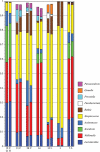
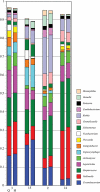


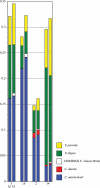

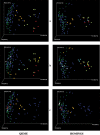
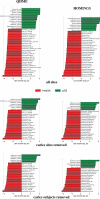
Similar articles
-
Microbiomes of Site-Specific Dental Plaques from Children with Different Caries Status.Infect Immun. 2017 Jul 19;85(8):e00106-17. doi: 10.1128/IAI.00106-17. Print 2017 Aug. Infect Immun. 2017. PMID: 28507066 Free PMC article.
-
Concordance of HOMIM and HOMINGS technologies in the microbiome analysis of clinical samples.J Oral Microbiol. 2016 Apr 8;8:30379. doi: 10.3402/jom.v8.30379. eCollection 2016. J Oral Microbiol. 2016. PMID: 27065347 Free PMC article.
-
Characterizing Microbiota from Sjögren's Syndrome Patients.JDR Clin Trans Res. 2021 Jul;6(3):324-332. doi: 10.1177/2380084420940623. Epub 2020 Jul 20. JDR Clin Trans Res. 2021. PMID: 32689841 Free PMC article.
-
Healthy Patients Are Not the Best Controls for Microbiome-Based Clinical Studies: Example of Sjögren's Syndrome in a Systematic Review.Front Immunol. 2021 Jul 29;12:699011. doi: 10.3389/fimmu.2021.699011. eCollection 2021. Front Immunol. 2021. PMID: 34394092 Free PMC article.
-
Sjögren's Syndrome: Oral Manifestations and Treatment, a Dental Perspective.J Dent Hyg. 2015 Dec;89(6):365-71. J Dent Hyg. 2015. PMID: 26684993 Review.
Cited by
-
High-Throughput Sequencing of Oral Microbiota in Candida Carriage Sjögren's Syndrome Patients: A Pilot Cross-Sectional Study.J Clin Med. 2023 Feb 16;12(4):1559. doi: 10.3390/jcm12041559. J Clin Med. 2023. PMID: 36836095 Free PMC article.
-
Association Between Nitrate-Reducing Oral Bacteria and Cardiometabolic Outcomes: Results From ORIGINS.J Am Heart Assoc. 2019 Dec 3;8(23):e013324. doi: 10.1161/JAHA.119.013324. Epub 2019 Nov 26. J Am Heart Assoc. 2019. PMID: 31766976 Free PMC article.
-
Why Should We Consider Potential Roles of Oral Bacteria in the Pathogenesis of Sjögren Syndrome?Immune Netw. 2022 Aug 3;22(4):e32. doi: 10.4110/in.2022.22.e32. eCollection 2022 Aug. Immune Netw. 2022. PMID: 36081525 Free PMC article. Review.
-
Potential non-invasive biomarkers of chronic sleep disorders identified by salivary metabolomic profiling among middle-aged Japanese men.Sci Rep. 2025 Apr 21;15(1):10980. doi: 10.1038/s41598-025-95403-1. Sci Rep. 2025. PMID: 40258870 Free PMC article.
-
Subgingival microbiome and clinical periodontal status in an elderly cohort: The WHICAP ancillary study of oral health.J Periodontol. 2020 Oct;91 Suppl 1(Suppl 1):S56-S67. doi: 10.1002/JPER.20-0194. Epub 2020 Aug 14. J Periodontol. 2020. PMID: 32533776 Free PMC article.
References
-
- Marsh PD, Moter A, Devine DA. Dental plaque biofilms: communities, conflict and control. Periodontol 2000. 2011;55:16–15. PubMed PMID: WOS:000285065800002; English. - PubMed
-
- Socransky SS, Haffajee AD, Cugini MA, et al.. Microbial complexes in subgingival plaque. J Clin Periodontol. 1998;25(2):134–144. - PubMed
-
- Leung KCM, Leung WK, McMillan AS. Supra-gingival microbiota in Sjögren’s syndrome. Clin Oral Investig. 2007December;11(4):415–423. PubMed PMID: WOS:000251009800014; English. - PubMed
Grants and funding
LinkOut - more resources
Full Text Sources
